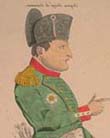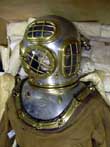| |
| |
THIS MONTH'S ARTICLE
'Napoleon; or, the Man of the World' from Representative Men (1850), by Ralph Waldo Emerson
"Among the eminent persons of the nineteenth century, Bonaparte is far the best known and the most powerful; and owes his predominance to the fidelity with which he expresses the tone of thought and belief, the aims of the masses of active and cultivated men." Though 150 years old, this article is still remarkably à propos.

|
|
|
| |
200 YEARS AGO
Napoleon's return to Paris (Fontainebleau, to be precise) was the occasion for the Emperor to make a comment about the state of the roads: "I could not have been more displeased", he wrote to Cretet on 23 Messidor, An XIII (12 July, 1805). "On the road from Lyons to Roanne, I thought I was back in the days of France's disorganisation. And this section is no better than the rest of the route. And it's not a question of lack of money. My orders are categorical. The roads from Paris to Turin must be kept in the best condition possible."
Napoleon had just appointed his stepson, Eugène, as viceroy of Italy, and it was his intention to keep him on a very short lead. The emperor wrote to him the following words on 24 Messidor, An XIII (13 July, 1805) : "My Cousin [royalty traditionally addressed their peers as cousins], I reached Fontainebleau eighty-five hours after leaving Turin. However, it took me three hours more than it should have done at Mount Cenis, and we had to keep stopping for the Empress, a couple of hours for lunch, a couple of hours for dinner, all in all, we wasted eight or nine hours. [sic !] From this you can see that with two good cabriolets you could get to Paris in seventy-two hours, if I summoned you. Thus you could do the return journey in fifteen days, and stay eight or ten days in Paris. When I next come back to Italy, I shall come without pomp and incognito." And he added later on, making his point: "Although I had it reported in the Milan papers that the journey from Turin lasted eighty hours, I must add that I intend to come a few times to Milan in three or four days, incognito, remaining there for a month, and returning in the same way."
The Journal des débats of 24 Messidor, An XIII (13 July, 1805) priased the new Parisian house numbering system imposed by the decree of 15 Pluviôse (4 February): "the new house numbering system can be seen in almost all the streets of Paris. All the houses on one side of the street are even numbers and those on the opposite side are odds; in this way you know immediately on entering the street which side the house you're looking for is on."
Up until the decree of 1805, only a few streets were numbered, and often in a haphazard way. Parisians would navigate their way round the city by means of the shop and craftsmen's signs. Attempts had been made to number the streets in Paris in the 1790s, but the system adopted was too complicated in that the district and arrondissement numbers were also indicated: pedestrians could find the same number at several different points in the street! With the decree of 1805, even numbers were set on the right-hand side of the street and odds were on the left, taking the river Seine as the orientation point (roads parallel to the river were numbered following the river as it flowed downstream). One final innovation: it was not doors but rather whole houses which were numbered.

|
|
|
| |
150 YEARS AGO
The Exposition universelle of 1855 was the occasion for the public to discover many different inventions, such as the diving suit or scaphander made by the inventor Joseph-Martin Cabirol. © Musée des Arts et Métiers, Paris (n° 08302-0001)
Wishing you an excellent, Napoleonic, week!
Peter Hicks
Historian and Web editor
Interested in the work of the Fondation Napoléon? Why not participate, either generally or in a specific project, by making a donation.
© this Napoleon.org weekly bulletin is published by the Fondation Napoléon. Reproduction or all or part of this bulletin is forbidden, without prior agreement of the Fondation Napoléon.

|
|
|
|
|
|
|
|
|
|
|
|
|
|
THIS WEEK
WHAT'S ON
- Exhibition: L'Isola dell'Imperatore: Le dimore di Napoleone. Da Residenze a Museo (The emperor's island: the Napoleonic residences, from houses to museums), Elba, Italy
- Exhibition: Nelson and Napoleon, National Maritime Museum, London, UK
- Exhibition: Il rifugio di Venere. La Villa Paolina Bonaparte, Viareggio, Italy
- Conference: War at Sea in the age of Nelson, The Trafalgar Bicentennial Conference, Christ Church, Oxford, UK
- Conference: Europe at War: the Trafalgar campaign in context, Senate House, London University, UK
- Conference: The Battle of Trafalgar Conference, at Action Stations, Portsmouth Historic Dockyard, UK
- For Napoleonic and Nelsonian 2005 bicentenaries, watch our 2005 bicentenaries page
THE MONTHLY TITLES
- This month's book: HILL, Peter P., Napoleon's Troublesome Americans: Franco-American Relations, 1804-1815
- This month's painting: The Immortality of Nelson, by Benjamin West (1807)
- This month's article: 'Napoleon; or, the Man of the World' from Representative Men (1850), by Ralph Waldo Emerson
- In the Collectors Corner, Bonaparte, First Consul, distributing honour sabres to the grenadiers of his guard after the Battle of Marengo, 14 June 1800
Got a problem with a link in the letter? Try the homepage
<<
|
|


